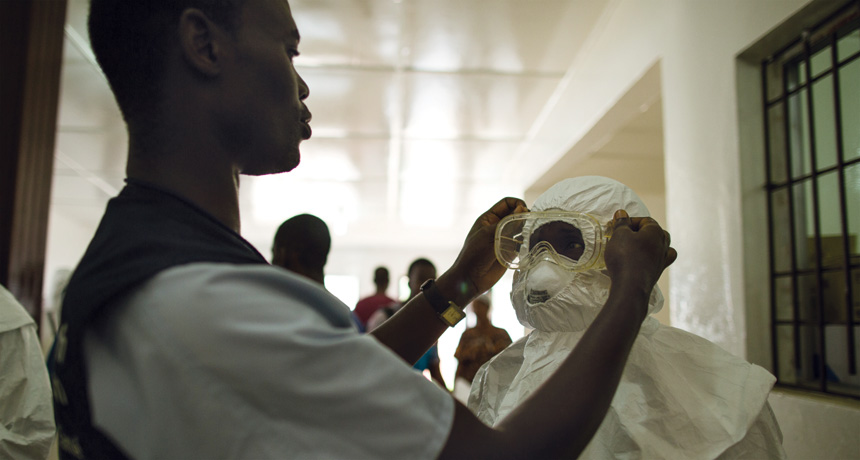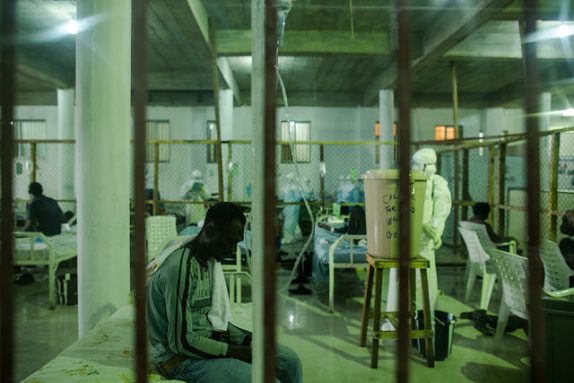Ebola epidemic could top 1 million, CDC warns
Numbers of sick and dying in West Africa continue to grow, not shrink

Sept. 22, 2014, photo of health care workers putting on protective gear at a day-old Ebola clinic in Monrovia, Liberia. Already, this 100-bed facility was filled to capacity.
Morgana Wingard / USAID/ Flickr (CC by NC-2.0)
By Janet Raloff
The Ebola virus has racked up a staggering number of victims since a small outbreak kicked off last December. The first case appears to have been a 2-year-old boy. He took sick the day after Christmas in the West African nation of Guinea. The people who cared for him got sick. So did their friends and their caregivers. Over the past nine months, this small outbreak has mushroomed out of control. As of September 23, Ebola has infected an estimated 5,864 people. Of these, at least 2,811 have died.
The current outbreak is now bigger than all earlier ones combined. That’s according to a September 23 report in the New England Journal of Medicine. In less than six weeks, it warns, 20,000 people could be infected.
This outbreak may not have grown this big if healers knew what they were dealing with when the disease first began to spread. But for three months, they mistook it for other things. And that’s not surprising.

Ebola’s major symptoms include fever, loss of appetite, vomiting, feeling very tired, diarrhea, headache and pain in the belly or gut. Those symptoms are common to lots of diseases. Ebola is best known for its ability to trigger uncontrolled bleeding. But it doesn’t always. In fact, fewer than one in five Ebola victims in West Africa has had “unexplained” bleeding, the new report finds. Fewer than 6 percent showed uncontrolled bleeding, or hemorrhaging. (In some places, fewer than 1 percent hemorrhage.) That helps explain why the disease wasn’t recognized early on.
Now an all-out crisis is underway. And this week, health officials warned the outbreak is nowhere near an end. Unless efforts to control the disease improve, there could be thousands of new infections each week in the coming months.
Sixty-one members of an Ebola Response Team authored the New England Journal of Medicine report. The World Health Organization, or WHO, convened this group of experts. The experts scoured recent health reports to detail the infection sweeping through five West African countries. Throughout the past nine months, they now conclude, the death rate in each country has been about the same: roughly 7 in every 10 people who get Ebola.
As scary as such numbers are, they are not the most pessimistic ones. The U.S. Centers for Disease Control and Prevention, or CDC, issued its own update on September 23. This government agency is based in Atlanta, Ga. The CDC now predicts that within a week, West Africa’s Ebola outbreak could top 8,000 victims. That’s just the “official” number. Experts at the CDC believe the actual infection numbers are 2.5 times as high as those that get reported. That would mean that by September 30, Ebola already would have sickened 21,000 people.
Even more worrisome, the official number of Ebola victims — just in Liberia and Sierra Leone — could reach 550,000 within another four months, the CDC says. That would translate to an estimated 1.4 million victims (after accounting for infections that never got officially reported). These dire figures appear in an “early release” report in the CDC’s Morbidity and Mortality Weekly Report.
All of the CDC and WHO projections assume that no improvements are made to control the disease. Yet it is still possible to get the disease under control and stop its spread, health-care officials say. Key to making the outbreak shrink, not swell, will be isolating the sick from the healthy. Such a separation of infected people is known as a quarantine.
So far, the three countries with the most victims have not been able to effectively quarantine people infected with Ebola. But doing so is essential, health officials warn, especially now that the disease is growing so rapidly. Rates of spread vary by country. In Guinea, the number of Ebola cases now doubles every 15.7 days, the WHO experts have calculated. That’s about half as long as it takes (30.2 days) for the number of Ebola infections to double in neighboring Sierra Leone. In Liberia, where almost half of the cases have developed this year, the doubling rate is around 23.6 days.Why the difference in doubling times? It has to do with how well and how quickly the infected people can be isolated from healthy people until the sick people get better or die.
Ebola spreads when a healthy person becomes exposed to fluids (such as urine, blood or saliva) from an infected person. If a sick individual lives in a large urban city — especially a slum — and can’t get to a hospital, the chance that he or she will infect another person is high.
Earlier outbreaks tended to occur in small rural or forested communities. There, the disease quickly died out because the sick people couldn’t reach many others to infect them. But in West Africa, Ebola has spread to huge cities, including the capitals of Guinea, Sierra Leone and Liberia. Moving a sick person to clinics risks infecting a taxi or truck driver and his vehicle. Even disposing of the dead poses heavy infection risks to hospital workers, families and burial crews.
It all comes down to a numbers game, the WHO Ebola team observes. If each sick person infects no more than one person, the size of the epidemic would remain stable or start to fall. But if each Ebola victim, on average, infects more than one person, the epidemic will grow. And that’s what’s happening now. Every 10 Ebola victims are together responsible for more than 10 new cases, the WHO expert panel finds. So the outbreak just keeps growing. The only way to shrink the size of the sick population, the panel concludes, is to keep each sick person from infecting more than one other person. And that’s what health officials mean when they say Ebola has to be “controlled.”
There are more sick people than hospital beds to care for them, the WHO report notes. New clinics are being built to treat and isolate Ebola patients. But in many areas, these clinics are not yet keeping pace with the growth in infections. And finding health care workers for them is difficult. Most people are understandably scared. To date, even with all of their protective gear and training, more than 170 health care workers have developed Ebola. Death rates among them have ranged from 56 percent in Guinea to 80 percent in Liberia, the WHO reports.
Power Words
Ebola A family of viruses that cause a deadly disease in people. Most cases occur in Africa and Asia. Its symptoms include headaches, fever, muscle pain and extensive bleeding. The infection spreads from person to person (or animal to some person) through contact with infected body fluids
epidemic A widespread outbreak of an infectious disease that sickens many people in a community at the same time
hemorrhage (adjective is hemorrhagic) Related to major or uncontrolled bleeding, often internally.
outbreak The sudden emergence of disease in a population of people or animals.
population A group of individuals from the same species that lives in the same area.
quarantine A temporary restriction on the movement of people (or animals) that are sick — or suspected of being infected — to a small area. The goal is to prevent a spread of their illness. If the illness is life-threatening and an epidemic is underway, police sometimes may be called in to enforce a government-imposed quarantine.
virus Tiny infectious particles consisting of RNA or DNA surrounded by protein. Viruses can reproduce only by injecting their genetic material into the cells of living creatures. Although scientists frequently refer to viruses as live or dead, in fact no virus is truly alive. It doesn’t eat like animals do, or make its own food the way plants do. It must hijack the cellular machinery of a living cell in order to survive.
World Health Organization An agency of the United Nations, established in 1948, to promote health and to control communicable diseases. It is based in Geneva, Switzerland. The United Nations relies on the WHO for providing international leadership on global health matters. This organization also helps shape the research agenda for health issues and sets standards for pollutants and other things that could pose a risk to health. WHO also regularly reviews data to set policies for maintaining health and a healthy environment.







